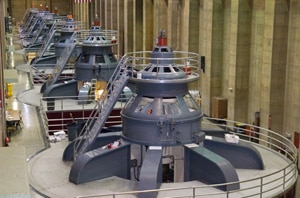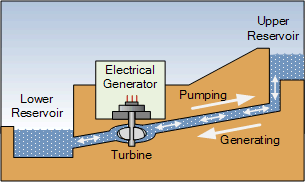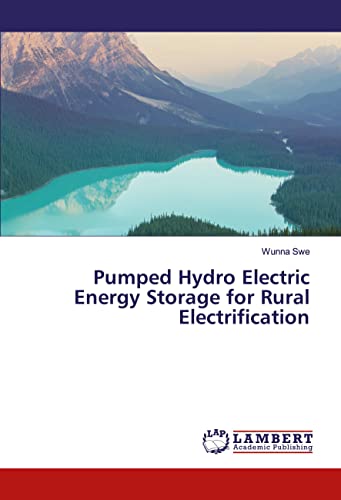
Pumped Hydro Storage
Pumped Hydro Storage – The Ups and Downs of Water
![]() Another form of hydro power that has been around for many years is Pumped Hydro Storage also known as “Pumped Hydroelectric Storage”. We know that among the variety of renewable energy resources available today, hydroelectric power is one of the most desirable for generating electricity because it is one of the most successful and widely used systems with a good and safe track record.
Another form of hydro power that has been around for many years is Pumped Hydro Storage also known as “Pumped Hydroelectric Storage”. We know that among the variety of renewable energy resources available today, hydroelectric power is one of the most desirable for generating electricity because it is one of the most successful and widely used systems with a good and safe track record.
The use of the stored potential and kinetic energy of water as a source of energy and power has been known for thousands of years. Watermills use giant waterwheels to grind or to mill grains and corns to produce flour. Today, large hydroelectric power plants use pumped hydro storage techniques to transform the waters energy into electricity.

Hydroelectricity is the term used to describe any electrical power source generated by the energy contained in water, but it is more generally used to refer to the electricity generated by hydroelectric dams.
These dams store the potential energy of the water behind huge concrete walls and harness the kinetic energy contained in the moving water once released converting it into mechanical energy by means of hydro turbines. These turbines drive electrical generators which convert the mechanical energy of a rotating shaft into electrical energy using generators which is then distributed to thousands, or even millions of homes over a network of electrical grids and cables.
The damming of a river and the creation of a reservoir behind the dam wall makes the water flow through the turbines more predictable and reliable throughout all of the year. The dam also raises locally the level of the water surface, thus increasing the potential energy that may be converted to electric power by increasing the head height.
Note that the term “Head” refers to the difference in level between the source of the water and the point at which energy is extracted from it, and assuming all things are equal, the higher the head, the more power is generated.
Types of Hydroelectric Schemes
Impoundment type hydro power and hydroelectric power generating stations use dam structures to store water. The harnessing of the hydroelectric power in conventional power plants relies on the head height and the mass flow rate of the water flow. When the water from the reservoir is released, the flow is controlled by sluice gates and vanes to maintain a constant output power.
While this type of energy generation has been used successfully for many decades, one of the draw backs with conventional hydro power dams and systems is that hydroelectricity depends on nature’s hydro-logic cycle.
This is where water in the form of rain or melting snow is used to fill the dams reservoir which then powers the hydroelectric plants turbines. But this is a one hit deal as the water released to generate electricity through the turbines flows away downstream. This results in the level of the reservoir water behind the dam lowering until mother nature creates more rain and snow to fill it back up again.
Also, with fluctuating power demands the quantity of water released from the dam may affect the level and amount of water in the rivers downstream as a lot of water may be released during high demand periods and less water released during low demand periods. Then there is an increasing need for bulk energy storage to supplement the periods of high demand to maintain a constant flow of the river downstream. This can be achieved using Pumped Hydro Storage.
Pumped Hydro Storage Basics
Pumped Hydro Storage is an extended version of a conventional hydroelectric system. The hydroelectric power plant is constructed from two reservoirs built at different altitudes. One being at a higher elevation than the other. For example, one in a lower valley and one higher up in the mountain.
In some places this can occur naturally, while in others one or both reservoirs of water are man-made. The upper reservoir when full operates exactly as the reservoir does in a high head dam hydroelectric plant.
During periods of electrical demand, the stored water from the higher reservoir is released (generating mode) converting the kinetic energy created by its discharge through waterways, pipes and turbines into electrical power. The difference this time is that instead of the water flowing away into the river downstream, the water exiting the plant is stored in a lower reservoir for later use rather than re-entering into the river.
Once the power generation period is complete, which usually occurs during the daytime or when the demand for electrical energy is at its highest, the same water now saved in the lower reservoir is pumped back uphill to the upper reservoir for storage (pumping mode).
Generally this is done using a single reversible turbine such as the “Francis Turbine” which continues to operate even when the direction of spinning is reversed. The motor used to drive the turbine-pump is powered by conventional electricity from the utility grid. This pumping process usually occurs overnight when electricity demand and the cost of electrical energy is at its lowest.
Then we can see that the same water is pumped up from a lower holding reservoir and then released down from a higher reservoir to generate electricity, and this is the basic principal of pumped hydro storage. The advantage of pumped hydro storage is that it gives the generating plant more water to use to generate electricity as the system acts like a giant battery for water storage.
In a conventional hydroelectric dam generating station, a substantial amount of water is needed to rotate the hydro turbines. However, a pumped hydro energy storage system is a closed-loop system, so water losses are fairly small as the same water is constantly being re-used.
Once the two reservoirs are filled, only top-up water is required. A typical system may loose as much as 20% of its energy during this generation and pumping cycle, but that’s still better than a 100% loss that occurs when the water is allowed to just flow away downstream.
Pumped hydro storage systems are reversible turbine-generator or motor-pump systems normally used as energy peaking and energy storage systems as they offer a valuable reserve of electricity when consumer demand rises unexpectedly as pumped storage plants, like other hydroelectric plants, can respond to load changes within seconds. Once established, little replenishment of the system is needed, just the height difference between the upper and lower reservoirs to maintain a flow.
Pumped Hydro Storage Advantages and Disadvantages
One of the main advantage of hydroelectric power is that it is renewable and generates no atmospheric pollution during operation reducing our reliance on expensive oil to meet peak energy demand. It also has relatively low operational and maintenance costs.
Another positive attribute of hydro storage plants is that it can be used where there is little natural water available to draw upon. Also, the upper or lower dams and reservoirs that hold the resulting water could be used as recreational facilities if their water levels do not rise and fall quickly or by too much in response to generation or pumping.
But hydroelectric and pumped hydro storage projects can have an enormous impact on the surrounding environment as they require a great deal of land resources. In conventional hydroelectric projects, a dam is typically built to create a large reservoir of water needed to produce the electrical power over long periods of time, so the construction of a hydroelectric dam may harm the ecosystem and affect the population surrounding a hydro project.
During operation, there is only minor changes to the rivers and ecosystem downstream of the two dams and to minimise the environmental impact of these dams further, pumped hydro storage can also make use of underground reservoirs and abandoned mine pits as lower dams or the use of pumped sea water to store the energy similar to that used in a tidal barrage or tidal lagoon.
However, the disadvantages of pumped hydro power generation include high initial capital cost and potential site-specific negative environmental and ecological impacts and the fact that the electrical power used for pumping the water back up the mountain could possibly come from other energy sources, such as nuclear, coal fired power stations, whose power output cannot be adjusted to follow load fluctuations.
On the one hand, it would be possible to pump the water into the upper basin with the help of a surplus of electric power generated from wind energy and other such renewable energy systems although the wind turbines and the pumped hydro storage system may not necessarily be installed at the same location. With the use of pipework and the countryside geological features, the upper and lower reservoirs of a pumped hydro storage system can be many miles apart.
Hydro power is a very flexible method of electricity generation and pumped hydro storage adds to this flexibility by using and storing large quantities of energy. With today’s state of the art turbine-pumps, pumped hydro storage plants are an interesting option for larger scale applications of energy storage allowing a way to store large quantities of electrical energy in the form of potential energy and using water as its fuel also has one of the highest cycle efficiencies of any energy storage process.











All renewable energy systems generally do not provide ‘Schedulable Power ‘ whereas consumers require the Schedulable Power. So the renewable energy – wind or Solar is used for upward pumping of the water and the hydro power is the Schedulable Power which is utilized. Particular advantage is feeding into the grid during times of peak tariff, for better commercial bottom lines
Just tell us straight, Is more electricity needed to pump the water up the hill than it creates going down the hill.
No!
What’s the net electrical power gain, based on similar power systems built so far i.e. electrical power produced during flow of water down stream – the electrical power required to pump the water to refill the reservoir? how is it stored and distributed? How is all system kept in Sync? what’s the FMECA, FTA, PFD ? I hope you are not going to say what what these acronyms are? What’s the optimum “quantity”, “altitude” and “distance” difference between the upper and lower reservoir. Greater the distance, greater the volume greater the power required to refill the upper reservoir. It can only be built in a valley?
What is the reliability required of the pumps to refill on a steady basis, over 95% operation on demand. What were the results of pilot scale studies or is this all including this massive investment in Andhra Pradesh in India based on theoretical studies?. was any simulation studies done? how was it validated and verified..
What happens during a drought, earth-quack, hurricane, land slides, mud slides e.g. case in point Arizona, USA?
You should direct your ridiculous questions to the Chief Engineers of the Canyon Creek Project, Calgary. The Meaford Project, Ontario, or the Brazeau project in Alberta, Canada as pumped hydro storage is a well established cost-effective technology used globally.
“With the use of pipework and the countrysides geological features, the upper and lower reservoirs of a pumped hydro storage system can be many miles apart.”
What part of using geographical features and many miles apart are conducive to pumping the water back to an upper reservoir?
There has to be a balance point in which the distance and height difference between the two reservoirs becomes unfeasible.
As explained in the tutorial. Pumped Hydro Storage is effectively a closed-loop system which uses the potential energy of a large volume of water to generate electricity. Water is contained within an upper reservoir and at periods of high electrical demand its stored potential energy is released into a lower reservoir under the influence of gravity, where it is transformed into electrical power using turbines. During periods of low electrical demand (commonly night time) the water is pumped back upto, and stored once again in the upper reservoir.
The topography and geographical features of the mountainside terrain would ultimately decide the distance between the two reservoirs and is not uncommon to have a paired straight line distance of a few miles (or kilometers) as a result of a head height of many hundreds of meters. The amount of energy storage, and therefore the generating capacity, of a pumped hydro system is clearly fixed as it is determined solely by the volume of water storage and the head height, which are both fixed physical topographical characteristics of the location.
One new line of thought is to use sea water as the energy source with the sea itself used as an endless supply of water within the lower reservoir. Tanks, dams and the terrain at the top of cliffs used as the upper reservoir.
How about trapping some water in e.g. an Ocean, Lake or fiord, pump it out to the surrounding water (huge reservoir, right?) when over producing electricity, and harvest electricity during windless and dark periodes when it runs back into the enclosure? This way you will not have to give up land for other purpurses, i.g. houses or farmland, nor pay for it. The dam(s) need to be just a few meters above the sea level not harming wiews much. And it could be build anywhere without the need for mountains. Not effective? Are you sure?
The use of a tidal barrage at the entrance to estuary’s and lagoons to generate electricity from the ebb and flow of the water already exists
Location, location, location! Great technology where appropriately used.
I would like to see a couple of case studies that utilize NET electrical yield and costs after factoring in pump costs.
Hi there
Is it possible to reverse the woter from the lower level back to upper level ?
As stated in the tutorial, in periods of low demand (generally night time), water is pumped and stored in an upper reservoir/pond. At high electrical demand, the potential energy of the stored water is released and transformed into electrical power. Then pumped hydro storage is used to store electrical energy by utilising the potential energy of water at a higher level
What type of generator is used for this process??
The last sentence of the third paragraph should read, “In turn, the turbine turns a generator that converts this mechanical energy into electrical energy that can be distributed to thousands, and even millions, of homes.” (Added the words “turns a generator that” for technical correctness.)